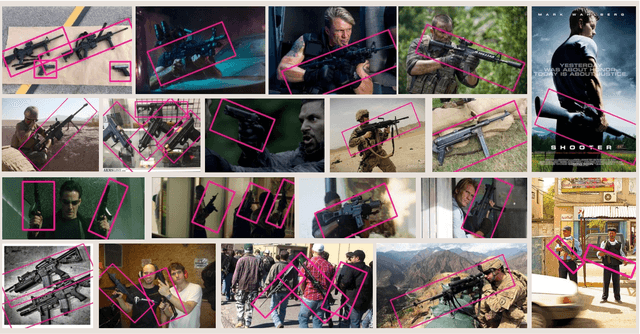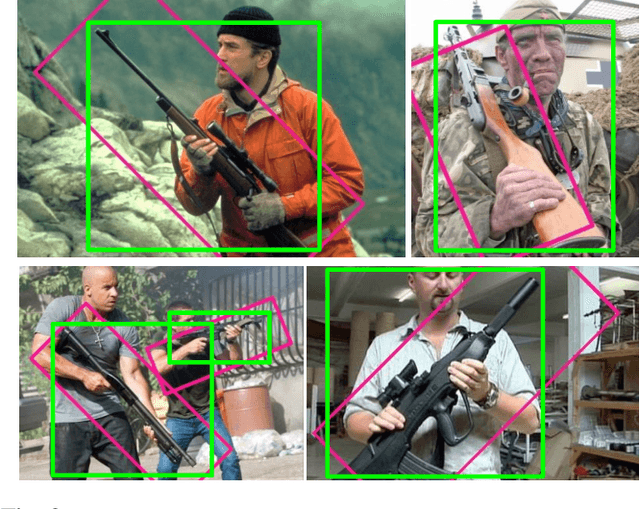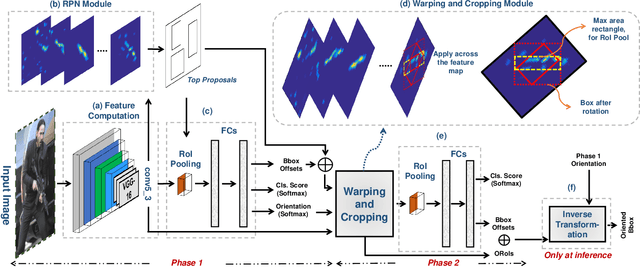Afsheen Rafaqat Ali
Orientation Aware Object Detection with Application to Firearms
Apr 22, 2019



Abstract:Automatic detection of firearms is important for enhancing security and safety of people, however, it is a challenging task owing to the wide variations in shape, size and appearance of firearms. To handle these challenges we propose an Orientation Aware Object Detector (OAOD) which has achieved improved firearm detection and localization performance. The proposed detector has two phases. In the Phase-1 it predicts orientation of the object which is used to rotate the object proposal. Maximum area rectangles are cropped from the rotated object proposals which are again classified and localized in the Phase-2 of the algorithm. The oriented object proposals are mapped back to the original coordinates resulting in oriented bounding boxes which localize the weapons much better than the axis aligned bounding boxes. Being orientation aware, our non-maximum suppression is able to avoid multiple detection of the same object and it can better resolve objects which lie in close proximity to each other. This two phase system leverages OAOD to predict object oriented bounding boxes while being trained only on the axis aligned boxes in the ground-truth. In order to train object detectors for firearm detection, a dataset consisting of around eleven thousand firearm images is collected from the internet and manually annotated. The proposed ITU Firearm (ITUF) dataset contains wide range of guns and rifles. The OAOD algorithm is evaluated on the ITUF dataset and compared with current state of the art object detectors. Our experiments demonstrate the excellent performance of the proposed detector for the task of firearm detection.
Emotional Filters: Automatic Image Transformation for Inducing Affect
Dec 20, 2017



Abstract:Current image transformation and recoloring algorithms try to introduce artistic effects in the photographed images, based on user input of target image(s) or selection of pre-designed filters. These manipulations, although intended to enhance the impact of an image on the viewer, do not include the option of image transformation by specifying the affect information. In this paper we present an automatic image-transformation method that transforms the source image such that it can induce an emotional affect on the viewer, as desired by the user. Our proposed novel image emotion transfer algorithm does not require a user-specified target image. The proposed algorithm uses features extracted from top layers of deep convolutional neural network and the user-specified emotion distribution to select multiple target images from an image database for color transformation, such that the resultant image has desired emotional impact. Our method can handle more diverse set of photographs than the previous methods. We conducted a detailed user study showing the effectiveness of our proposed method. A discussion and reasoning of failure cases has also been provided, indicating inherent limitation of color-transfer based methods in the use of emotion assignment.
High-Level Concepts for Affective Understanding of Images
May 08, 2017



Abstract:This paper aims to bridge the affective gap between image content and the emotional response of the viewer it elicits by using High-Level Concepts (HLCs). In contrast to previous work that relied solely on low-level features or used convolutional neural network (CNN) as a black-box, we use HLCs generated by pretrained CNNs in an explicit way to investigate the relations/associations between these HLCs and a (small) set of Ekman's emotional classes. As a proof-of-concept, we first propose a linear admixture model for modeling these relations, and the resulting computational framework allows us to determine the associations between each emotion class and certain HLCs (objects and places). This linear model is further extended to a nonlinear model using support vector regression (SVR) that aims to predict the viewer's emotional response using both low-level image features and HLCs extracted from images. These class-specific regressors are then assembled into a regressor ensemble that provide a flexible and effective predictor for predicting viewer's emotional responses from images. Experimental results have demonstrated that our results are comparable to existing methods, with a clear view of the association between HLCs and emotional classes that is ostensibly missing in most existing work.
 Add to Chrome
Add to Chrome Add to Firefox
Add to Firefox Add to Edge
Add to Edge